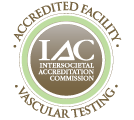Angioplasty is a non-surgical procedure used to treat heart disease by unblocking arteries in the heart and restoring normal blood flow. During this minimally invasive procedure a thin plastic tube called a catheter is inserted into the arm or groin and navigated through the blood vessels to the blockage in the heart artery. Once a blockage is reached, one of the following interventional angioplasty procedures is performed:
- Balloon Angioplasty: a catheter with a small balloon tip is guided to the location where your artery is narrowed or blocked. Once positioned, the balloon is inflated to compress the plaque against the wall of your artery. As the artery wall is compressed, it stretches and the artery opens to increase the flow of blood to the heart.
- Stent Placement: a small metal mesh tube called a stent is inserted into the narrowed artery to act as a scaffold to support the inner parts of your coronary artery. Once positioned, the balloon is inflated and the stent expands the artery and holds it open. To reduce the risk of restenosis or blocking again, your doctor may use a drug-eluting stent (a stent that contains medicine) to prevent the formation of scar tissue in the artery.
- Cutting Balloon: a specially designed catheter with a balloon tip and small cutting blades is used to score the plaque on the artery wall and compress the plaque against the walls of the artery.
Preparing for an Angioplasty
Before the scheduled angioplasty procedure your doctor will review your medical history, prescribed medications, and history of allergic reactions. Routine blood tests and electrocardiogram will also performed. You must refrain from eating and drinking for six to eight hours before the procedure. Follow your doctor’s instructions and take all medications.
What to expect during an Angioplasty
The first step of angioplasty is called cardiac catheterization. You will receive medication for relaxation and a local anesthesia to numb the area where the catheter will be inserted. A thin plastic tube called a sheath is inserted into an artery, either in the groin or the arm. Then a long, narrow and hollow tube known as a catheter is passed through the sheath, up the blood vessels to the arteries around the heart. Contrast material is injected through the catheter and then digital images are produced of the flow of the material through the heart chambers and major vessels. If your arteries appear narrow or blocked, the doctor will proceed with interventional angioplasty steps. Angioplasty can take half an hour to several hours depending on the number of blockages and whether complication arises.
What to expect after an Angioplasty
After the procedure you must rest until the artery where the sheath was inserted has sufficiently healed; usually a couple of hours. If your angioplasty included placement of a stent, you will need to take medication to reduce the chance of a blood clot. You may feel weak and tired after the procedure; rest for a few days and then gradually increase your activities. You will be able to resume your normal routine or return to work a week after angioplasty.
Specific after care orders will be provided by your doctor, but most after care instructions will include:
- Drink lots of fluid to help flush the contract material from your body.
- Wash the catheter insertion area with soap and clean water at least once a day and keep the area dry if you are not taking a shower.
- Avoid ointment, lotions and creams on the wound area and put on loose clothes.
- Ensure you do not strain during the bowel movement a few days after the procedure to avoid any bleeding from catheter insertion area.
- Avoid any strenuous activity for at least two days after the procedure.
Risk factors for Angioplasty
As with any procedure, there are risks involved with angioplasty. These could include:
- Bleeding or bruising under the skin at the catheter insertion site.
- Allergic reaction to the contrast material or the dye used during the procedure.
- Blood clot near the newly implanted stent.
Contact your vascular expert
Call your vascular expert if you have any concerns or questions regarding your treatment. If you experience any of the following, contact your vein expert right away:
- bleeding
- swelling
- signs of infection
- chest pain
- shortness of breath.



